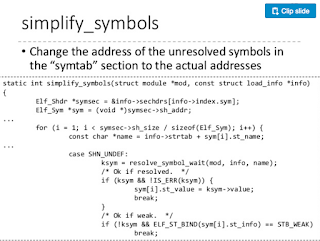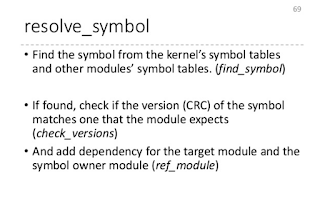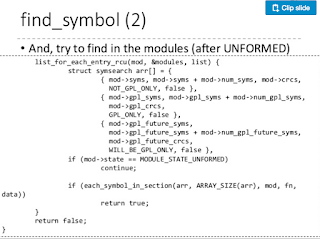How LKM A can call functions exported by LKM B?
When LKM B is loaded, Exported symbols are registered to system symbol table in Linux kernel.
When LKM A is loaded, system do binary search in system symbol table and other modules' symbol table to resolve symbols referenced by LKM A.
Reference
https://www.slideshare.net/shimosawa/nlkb20150221
2018/03/28
GNU's LMA and VMA
What is LMA and VMA
Every loadable or allocatable output section has two addresses. The first is the VMA, or virtual memory address. This is the address the section will have when the output file is run. The second is the LMA, or load memory address. This is the address at which the section will be loaded. In most cases the two addresses will be the same. An example of when they might be different is when a data section is loaded into ROM, and then copied into RAM when the program starts up (this technique is often used to initialize global variables in a ROM based system). In this case the ROM address would be the LMA, and the RAM address would be the VMA.
You can see the sections in an object file by using the objdump program with the -h option.
Configure LMA/VMA in Linker Script
The full description of an output section looks like this:
section [address] [(type)] : [AT(lma)]
{
output-section-command
output-section-command
...
} [>region] [AT>lma_region] [:phdr :phdr ...] [=fillexp]
Generating Binary Image (to burn to Flash)
objcopy can be used to generate a raw binary file by using an
output target of `binary' (e.g., use `-O binary'). When
objcopy generates a raw binary file, it will essentially produce
a memory dump of the contents of the input object file. All symbols and
relocation information will be discarded. The memory dump will start at
the load address of the lowest section copied into the output file.Move LMA to VMA
GNU toolchain does not have scattering mechanism like that in ARM toolchain. so BSS (zero init) part needs to be init by startup code. no library to do that.
How to find out the .bss part? via __bss_start__ and __bss_end__
_cstartup:
/* Relocate .fastcode section (copy from ROM to RAM) */
LDR r0,=__fastcode_load
LDR r1,=__fastcode_start
LDR r2,=__fastcode_end
.fastcode : {
__fastcode_load = LOADADDR (.fastcode);
__fastcode_start = .;
*(.glue_7t) *(.glue_7)
*isr.o (.text.*)
*(.text.fastcode)
*(.text.Blinky_dispatch)
/* add other modules here ... */
. = ALIGN (4);
__fastcode_end = .;
} >RAM AT>ROM
Reference
https://access.redhat.com/documentation/en-US/Red_Hat_Enterprise_Linux/4/html/Using_ld_the_GNU_Linker/scripts.html#BASIC-SCRIPT-CONCEPTS
https://www.embedded.com/design/mcus-processors-and-socs/4007119/Building-Bare-Metal-ARM-Systems-with-GNU-Part-1--Getting-Started
http://www.delorie.com/gnu/docs/binutils/ld_19.html
http://www.delorie.com/gnu/docs/binutils/ld_33.html
https://ftp.gnu.org/old-gnu/Manuals/binutils-2.12/html_chapter/binutils_3.html
2018/03/16
Install Old Kernel In Ubuntu
In Synaptics
Find below packets to install.
linux-headers-4.4.0-XX
linux-headers-4.4.0-XX-generic
linux-image-4.4.0-XX-generic
linux-image-extra-4.4.0-XX-generic
linux-signed-image-4.4.0-XX-generic
Find below packets to install.
linux-headers-4.4.0-XX
linux-headers-4.4.0-XX-generic
linux-image-4.4.0-XX-generic
linux-image-extra-4.4.0-XX-generic
linux-signed-image-4.4.0-XX-generic
Windows Blue Screen: ATTEMPTED_SWITCH_FROM_DPC
While debugging my windows driver, I got a blue screen with error code ATTEMPTED_SWITCH_FROM_DPC,
MS doc says one cannot wait in a DPC:
A wait operation, attach process, or yield was attempted from a DPC routine. This is an illegal operation.
https://docs.microsoft.com/en-us/windows-hardware/drivers/debugger/bug-check-0xb8--attempted-switch-from-dpc
I think it relates to locking a resource with WdfWaitLockAcquire(), which is called in a completion function of a IO request.
MS doc says:
If the driver services the I/O request by creating I/O activity on the device, the driver typically calls WdfRequestComplete from its EvtInterruptDpc or EvtDpcFunc callback function.
https://docs.microsoft.com/en-us/windows-hardware/drivers/wdf/completing-i-o-requests
So the completion function could be called in the DPC context.
I can use spin lock though:
On the other hand, they can acquire and release a driver's executive spin lock with KeAcquireSpinLockAtDpcLevel and KeReleaseSpinLockFromDpcLevel, which run faster than KeAcquireSpinLock and KeReleaseSpinLock.
https://docs.microsoft.com/en-us/windows-hardware/drivers/kernel/guidelines-for-writing-dpc-routines
MS doc says one cannot wait in a DPC:
A wait operation, attach process, or yield was attempted from a DPC routine. This is an illegal operation.
https://docs.microsoft.com/en-us/windows-hardware/drivers/debugger/bug-check-0xb8--attempted-switch-from-dpc
I think it relates to locking a resource with WdfWaitLockAcquire(), which is called in a completion function of a IO request.
MS doc says:
If the driver services the I/O request by creating I/O activity on the device, the driver typically calls WdfRequestComplete from its EvtInterruptDpc or EvtDpcFunc callback function.
https://docs.microsoft.com/en-us/windows-hardware/drivers/wdf/completing-i-o-requests
So the completion function could be called in the DPC context.
I can use spin lock though:
On the other hand, they can acquire and release a driver's executive spin lock with KeAcquireSpinLockAtDpcLevel and KeReleaseSpinLockFromDpcLevel, which run faster than KeAcquireSpinLock and KeReleaseSpinLock.
https://docs.microsoft.com/en-us/windows-hardware/drivers/kernel/guidelines-for-writing-dpc-routines
Subscribe to:
Posts (Atom)
Post Code on Blogger
Simplest way to post code to blogger for me: <pre style="background: #f0f0f0; border: 1px dashed #CCCCCC; color: black;overflow-x:...
-
Explain There is not interrupt PIN for PCIe interrupt. When device wants to raise an interrupt, an interrupt message is sent to host via ...
-
Configure Space Addressing One of the major improvements the PCI Local Bus had over other I/O architectures was its configuration mechanism...
-
What is LMA and VMA Every loadable or allocatable output section has two addresses. The first is the VMA, or virtual memory address. This ...





